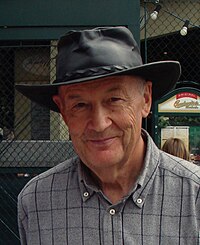
Photo from wikipedia
Detailed photochemical and photocytotoxicity studies of two new porphyrins: 5,10,15,20-meso-tetrakis-(4-acetoxy-3-methoxyphenyl) porphyrin (P2.1) and 5-(4-hydroxy-3-methoxyphenyl)-10,15,20-tris-(4-acetoxy-3-methoxyphenyl)porphyrin (P2.2) are reported, as potential candidates for theranostics. For powdered samples of P2.1 and P2.2 adsorbed… Click to show full abstract
Detailed photochemical and photocytotoxicity studies of two new porphyrins: 5,10,15,20-meso-tetrakis-(4-acetoxy-3-methoxyphenyl) porphyrin (P2.1) and 5-(4-hydroxy-3-methoxyphenyl)-10,15,20-tris-(4-acetoxy-3-methoxyphenyl)porphyrin (P2.2) are reported, as potential candidates for theranostics. For powdered samples of P2.1 and P2.2 adsorbed onto a powdered biocompatible substrate, polyethylene glycol (PEG), a concentration study was performed, correlating the fluorescence emission intensity with sample absorption to determine the useful concentration range for photodynamic therapy of cancer (PDT) in which aggregation does not occur. Fluorescence emission quantum yields and lifetimes were also determined for all samples under study, because it is well known that these parameters for aggregated porphyrins are lower than those obtained for the monomeric forms of the photosensitizers and the same occurs with the singlet oxygen quantum yields, therefore decreasing the PDT action. Cytotoxicity studies were performed in dark and illuminated conditions, using four different human tumor cell lines and one non-tumor primary cell culture. The two porphyrins evidenced very good photodynamic activity, as the inhibition for tumor cellular growth after excitation in the phototherapeutic window evidenced GI50 values smaller than 5 M in most cases. A comparison with tetraphenylporphyrin was made in order to evidence the extreme importance of the hydrophilic and hydrophobic tetrapyrrolic substituents to the PDT behaviour.
Journal Title: Current drug discovery technologies
Year Published: 2019
Link to full text (if available)
Share on Social Media: Sign Up to like & get
recommendations!